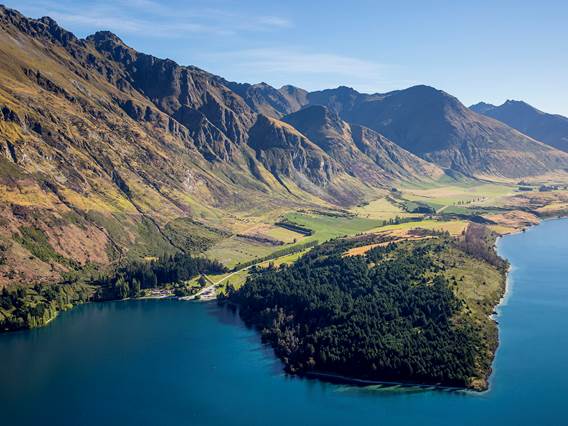Save $500pp on a Discovery Expedition Cruise






Walter Peak Land Restoration Project
Until recently, parts of Walter Peak were covered in wilding conifers which are considered a major threat to New Zealand’s unique landscape, and the country’s fastest growing pest. Travel to Walter Peak High Country Farm now and instead you’ll see thousands of small native shrubs and trees around the lakeside enveloped in green protective sleeves.
The extensive planting (and weeding) is the final and ongoing part of Real Journeys ambitious award-winning conservation project to stop the spread of invasive wilding pines and return the land to its natural heritage.
Planted as far back as the 1880’s, the first settlers at Walter Peak introduced hundreds of pines to help protect the homestead. A century later and the fast-growing trees were heavily infesting the area, not only destroying the natural habitat of native species but providing a rich seed source that was spreading wildings rapidly across the mountainsides in front of Queenstown. The authentic Central Otago landscape was slowly disappearing.
At the end of 2013 Real Journeys purchased Walter Peak High Country Farm (a 155 hectare property it had leased for years). As a responsible landowner and one with a proud tradition in conservation and kaitiakitanga (Maori term for guardianship, care, wise management), it was decided that the wilding pines, thousands of them, had to go. It was the start of what will be an ongoing 10 year programme.
What we've been doing
Clearing thousands of wilding trees from an area accessible only by boat or remote gravel back road was no easy task.
Working in partnership with the Wakatipu Wilding Conifer Control Group (WCG) and the Department of Conservation (DOC), a plan was developed. In the winter of 2015 under specific climatic and operational conditions, the smaller wilding pines were sprayed. Logging of the larger pines followed and 4000 tonnes of the best timber (20% of the trees) was trucked out to Bluff for export. This helped offset a small portion of the cost of the project.
The rest of the trees were inferior timber that was slashed and trimmed, then cut up for firewood. The remaining stumps were burnt or buried.
It was difficult work in tough winter conditions, made harder by a strict schedule revolving around the timetable of the TSS Earnslaw so as not to disrupt visitor arrivals.
What we're taking out
The wilding pine
It may not look it at first glance but the wilding pine is one of New Zealand’s biggest weeds that is spreading by about 90,000 hectares a year. These invasive trees were introduced by settlers in the 19th century. They grow fast and each tree produces tens of thousands of seeds per tree. They compete with native plants and animals for sunlight and water and can severely alter natural landscapes. Wildings overpower the native bush, tussock and beech forests, blanketing the high country with conifer needles and destroying the natural habitat for a large number of native species. They create ‘tree deserts’ which are eerily silent, the New Zealand environment is simply not equipped to deal with them. They are also a fire risk and absorb precious water that will not flow down our rivers.
Gorse, broom and other pests
There are a number of other invasive plants that threaten our native landscape if left unchecked. Introduced during European settlement, gorse is now one of New Zealand’s biggest agricultural pests. Gorse seeds can lie dormant in the ground for up to 50 years. New Zealand has a number of native species of broom, however the introduced common broom (or Scottish broom) is a well known agricultural weed. It has been estimated that broom costs New Zealand farms and forestry over $100 million annually.
Wonderful that an eco-friendly company like Real Journeys is tackling the wilding issue.
Peter Willsman, Founding Chairman of Wakatipu Wilding Conifer Group
What we're bringing back
A unique environment
Mountain and red beech, kowhai, cabbage trees, rata and pittosporum are already growing rapidly helped by a good irrigation system that Real Journeys installed early on.
Replanting key pockets of native trees and other species found around Lake Wakatipu will attract wildlife back into the area.
The return of the forest will also bring back the native birds and insects that once flourished on this site.
A way of life
There is a rich history of farming at Walter Peak, from the first European settlement in the 1860s by Nicholas Von Tunzelmann, to further development in the 1880s under the Mackenzie family, through to the present day operation. In keeping with the heritage of the land, the flatter inland areas will be maintained for traditional pastoral farming, which will also help keep the weeds under control. The grounds directly around the historic Colonel’s Homestead will remain ‘in keeping’ with its traditional exotic planting.
A sense of adventure
A partnership between Real Journeys and the DOC has seen a new track built from the Walter Peak wharf to Beach Point where a picnic and camping area was created complete with toilet, a day shelter, barbecue and picnic table. Real Journeys has built these public facilities and will maintain them.
There has been public interest in the project. The Wakatipu Reforestation Trust offered 500 plants for a further volunteers' planting day, which was held on the adjacent DOC land (which Real Journeys also cleared of wildings) in September 2017.
The removal of the trees has opened up incredible vistas that were previously hidden from view.
The timeline
November 2013
Real Journeys purchases the 155 hectares of land that makes up Walter Peak High Country Farm
February 2015
15.4 hectares of wilding pines sprayed
Winter 2015
Logging of the best wilding pines - 4,000 tonnes removed
Start of land clearance with excavators
Public walkway to Beach Point built
August 2015
Native planting scheme begins and grass sown
Winter 2016
Cut-down and clearance of rest of wilding pines, stumps and roots removed, buried or burnt
December 2016
Opening of public walkway, picnic and barbecue area at Beach Point
2016/2017
12,000 native trees and shrubs planted, ongoing weed control
2017 - 2025
Ongoing planting and weed control
Contribution recognised
The restoration work being undertaken at Walter peak was acknowledged by the Department of Conservation(DOC) with a ‘Certificate of Appreciation’ awarded to Real Journeys in November 2015.
Real Journeys former Commercial Director, Tony McQuilkin spearheaded the project. Before embarking on the project, Tony consulted with the Wakatipu Wilding Conifer Group and Department of Conservation about best practise wilding pine eradication, then engaged renowned ecologist Neill Simpson (awarded the Queen's Services Medal for conservation) to come up with the replanting vision. Neill also conducted a review of the planting.
This will go a long way towards helping control the problem for everyone.
Mark Nelson - Department of Conservation
Other useful links:
Ministry for Primary Industries - Long term pest management - wilding conifers
Real Journeys is involved in other conservation projects - learn more
Key Conservation Projects
- Cooper Island Restoration Project
- Walter Peak Land Restoration Project
- ‘Putangi’ Conservation Wine
- The Kakariki Karaka Translocation Project

